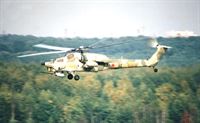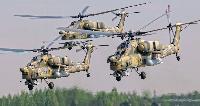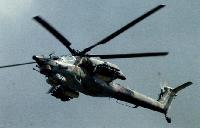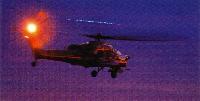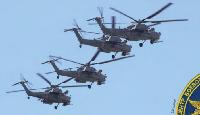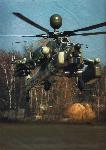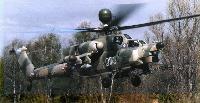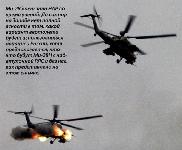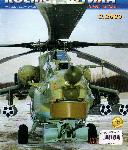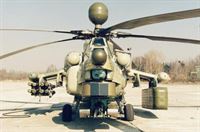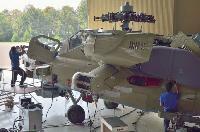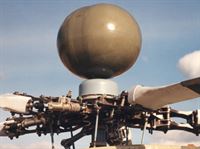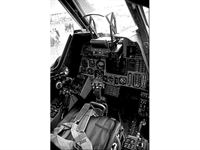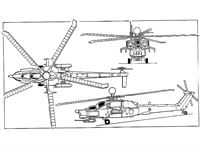
Описание
Страна : Россия
Год : 1982
Вертолет
Боевой вертолет с экипажем из двух человек
Ми-28
Несмотря на всю историю достаточно неоднозначных результатов сравнительных испытаний с вертолетом Ка-50, Ми-28 в будущем должен стать стандартным боевым вертолетом российской армии. Ми-28 спроектирован по классической одновинтовой схеме, члены экипажа расположены тандемом с превышением задней кабины над передней. Под носовой частью фюзеляжа установлена пушечная турель. Первый из четырех прототипов Ми-28 выполнил первый полет 10 ноября 1982 года. Два первых вертолета были оснащены ТВаД семейства ТВ3-117 ОКБ им. В. Я. Климова мощностью по 1923 л.с. (1434 кВт) с отклоненными вверх соплами. В носовой части фюзеляжа имелся неподвижный обтекатель оптоэлектронной обзорно-прицельной системы. Первый прототип имел трехлопастный рулевой винт, на втором установили четырехлопастный Х-образный рулевой винт. Третья и четвертая опытные машины построены в варианте Ми-28А. Сравнительные испытания Ка-50 и Ми-28 явного победителя не выявили. Предпочтение тогда отдали Ка-50, но ограниченной серией собирались строить и Ми-28. На Ми-28Н установлена надвтулочная РЛС по типу вертолета Longbow Apache. Первый серийный Ми-28 передан Вооруженным силам России в 2006 году. К началу 2012 года заказано не менее 60 Ми-28, более 30 вертолетов уже поступили в войска. Первый экспортный заказ на 10 машин варианта Ми-28Н поступил в 2010 году от Венесуэлы.
Фюзеляж полумонококовой конструкции изготовлен из легких сплавов, в районе кабины и важных элементов конструкции установлена титановая броня. Шасси неубираемое, трехопорное с хвостовой опорой.
Ми-28 вооружен 30-мм пушкой 2А42, орудие установлено на подфюзеляжной турели. Боекомплект в 300 снарядов размещен в двух ящиках, установленных тоже на турели, что снижает вероятность заклинивания снаряда при подаче к пушке. Скорострельность пушки составляет 300 выстрелов в минуту при стрельбе по наземным целям и 900 выстрелов в минуту при стрельбе по воздушным целям.
Подвесное вооружение крепится к четырем пилонам небольшого крыла. В типовой вариант боевой нагрузки входят 16 ПТУР 9М120 "Атака-В", блоки НАР калибра 55 мм или 80 мм, УР класса "воздух-воздух" малой дальности 9К38 "Игла", кассетные бомбы. Приборное оборудование кабин совместимо с очками ночного видения. В кабине летчика установлены ИЛС и жидкокристаллический индикатор, на который выводится ТВ-изображение. На гиростабилизированной носовой турели установлены оптоэлектронная обзорно-прицельная система и лазерный дальномер-целеуказатель. Вертолет оснащен системами пассивной защиты: блоками отстрела ложных целей, приемником предупреждения об электромагнитном и лазерном облучении, в законцовках крыла размещена аппаратура постановки помех.
Плоское остекление кабин выполнено из бронестекла. Кабины защищены титановой и керамической броней. Жизненно важные системы также защищены броней и продублированы. Реализован и принцип защиты более важных агрегатов менее важными. Члены экипажа размещены на энергопоглощающих креслах, рассчитанных на парирование удара при аварийной посадке с вертикальной скоростью до 12 м/с. Имеется система аварийного спасения членов экипажа. В аварийной ситуации отстреливается боковое остекление кабин и консоли крыла, по бортам фюзеляжа надуваются баллонеты, по которым экипаж покидает вертолет, после чего открывает парашюты. В задней части фюзеляжа по левому борту имеется люк для доступа в отсек БРЭО и большой отсек, в котором возможна перевозка двух или даже трех человек, то есть Ми-28 способен эвакуировать экипаж сбитого боевого вертолета или самолета.
ТАКТИКО-ТЕХНИЧЕСКИЕ ХАРАКТЕРИСТИКИ
Ми-28А
Тип: боевой вертолет с экипажем из двух человек
Силовая установка: два ТВаД ТВ3-117 по 2194 л. с. (1636 кВт)
Летные характеристики: максимальная скорость на оптимальной высоте без внешних подвесок 300 км/ч; максимальная крейсерская скорость на оптимальной высоте 270 км/ч; максимальная скороподъемность 816 м/мин; практический потолок 5800 м; статический потолок без учета влияния земли 3600 м; дальность со стандартной заправкой 470 км
Масса: пустого 7900 кг; максимальная взлетная 10 200 кг
Размеры: диаметр несущего винта 17,20 м; размах крыла 4,87 м; длина с вращающимися винтами 19,15 м; высота 4,70 м; площадь, ометаемая несущим винтом, 232,35 м2
Вооружение: одна 30-мм пушка 2А42 на подфюзеляжной турели, вооружение массой до 1920 кг на четырех подкрыльевых пилонах
Полезная нагрузка: до трех человек в фюзеляжном отсеке
- Описание
Фотографии
-
Мировая Авиация 105
Вертолет Ми-28, получивший в НАТО обозначение "Havoc", создавался как специализированный боевой вертолет для замены многоцелевого Ми-24. В результате конструкторы отказались от полноразмерной десантной кабины, сосредоточив свои усилия на повышении боевой живучести новой машины.
-
Авиация и Космонавтика 2014-08 / ??? - История "Черной акулы" глазами создателей /Вертолетная техника/ (2)
Первый летный экземпляр вертолета Ми-28
-
Мировая Авиация 103
ОАО "МВЗ им. М. Л. Миля" в конечном счете получило госзаказ на вертолеты Ми-28 и продолжает активно продвигать на рынок эти машины.
-
Мировая Авиация 103
Оба двигателя Ми-28 оснащены композитными кожухами, которые направляют струи выхлопных газов вниз, хотя на одном из прототипов, как сообщалось, испытывались кожухи, обращенные вверх.
-
Мировая Авиация 194
В конечном итоге, Ми-28 стал поступать на вооружение российской армии в ощутимом количестве. Целевое оборудование Ми-28А (на фотографии) не столь совершенно, как у ночного Ми-28Н.
-
Jane's All the World Aircraft 2000 / 2-05 - AIRCRAFT - ROTARY-WING - MILITARY/CIVIL
Second prototype Mil Mi-28A combat helicopter (1999)
-
Air International 2013-02 / Attack helicopters (1)
By December 2012, no fewer than 50 Mi-28Ns were reported to have been delivered to the Russian Air Force Army Aviation Branch operated by one training centre and two front line air bases.
-
Авиация и Космонавтика 2013-10 / А.Юргенсон - МАКС-2013
Вертолеты Ми-28Н
-
Мировая Авиация 103
Ми-28 концептуально ближе к западным боевым вертолетам, таким как AH-64 и Tiger, чем к своему предшественнику Ми-24. Он утратил роль десантно-транспортной машины и обрел компоновку многофункционального ударного вертолета.
-
Air International 2013-02 / Attack helicopters (1)
Регистрационный номер: RF-95648 The Mi-28N is routinely employed on the battlefield in two-ship formations for close air support and anti-tank missions.
-
Air International 2016-08 / P.Butowski - Success Years Later /Military/
By 2020 Mi-28N will be the most widespread combat helicopter in service with the Russian armed forces.
-
Air International 2014-01 / P.Butowski - Russia's Vision 2025 /Military/
Russia's fleet of Mi-28N Havoc attack helicopters will be upgraded by 2020.
-
Air International 2016-08 / P.Butowski - Success Years Later /Military/
This helicopter, ‘03’, was one of the first operational Mi-28Ns. Note the NPPU-280-1 nose turret with flexible single-barrel 30mm 2A42-2 cannon and 250 rounds in side magazines. The I-256 radio-command guidance datalink for the Ataka missile is fitted in the nose tip.
-
Авиация и Космонавтика 2014-09 / О.Колтаков - Авиационной технике - долгую жизнь /Промышленность/
Регистрационный номер: RF-93275 -
Авиация и Космонавтика 2021-06 / А.Харланов - Авиадартс-2021 /Фоторепортаж/
Регистрационный номер: RF-95635 Авиадартс-2021. Отборочный этап в ЮВО.
-
Авиация и Космонавтика 2017-02
Регистрационный номер: RF-95315 [2] -
Авиация и Космонавтика 2014-06
Регистрационный номер: RF-95319 Вертолеты армейской авиации - участники Парада Победы в Москве
-
Air International 2013-02 / Attack helicopters (1)
Регистрационный номер: RF-95653 Mi-28N RF-95653 is operated by the Russian Air Force Army Aviation's 334th Combat Training and Aircrew Conversion Centre at Torzhok north of Moscow. The centre undertakes pilot and weapons system operator conversion training and also develops new combat employment tactics, techniques and procedures.
-
Авиация и Космонавтика 2011-11 / Д.Пичугин - Учение "Щит Союза-2011"
Регистрационный номер: RF-95654 -
Авиация и Космонавтика 2016-02 / Г.Муравьев, А.Бежко, А.Лукашов, В.Сосницкий - Вертолетчики
Регистрационный номер: RF-93942 [2] -
Air International 2013-02 / Attack helicopters (1)
Регистрационный номер: RF-93942 [2] Mi-28N RF-93942 seen at Klin during rehearsals for the Russian Air Force 100th anniversary airshow in August 2012.
-
Авиация и Космонавтика 2021-08 / А.Китаев - На малых высотах
Регистрационный номер: RF-91095 -
Авиация и Космонавтика 2023-11
Регистрационный номер: RF-95325 [2] -
История Авиации 36 / А.Булах - Небо "незалэжной" нэньки /Авиация в локальных войнах/ (1)
Ми-28 из состава 546-й Авиационной базы Армейской авиации в Ростове.
-
Air International 2011-11 / J.Schoofs - Military at MAKS /Military/
The Russian Ministry of Defence placed its first order for 67 Mil Mi-28N Havoc night capable attack helicopters in 2005 to replace ageing Mil Mi-24 Hinds. Between 2005 and 2008, seven preproduction (32 to 38 Yellow) and four production-series Mi-28Ns (41 to 44 Yellow) were delivered by the Rostvertol Helicopter Plant at Rostov-on-Don to the 344th Combat Training and Aircrew Conversion Centre in Torzhok. At least 27 production aircraft are currently in service with frontline units in Budyonnovsk (01 to 12 Blue and 14 to 17 Blue) and Korenovsk (01 to 11 White). Deliveries will continue in 2011 and 2012 at an annual rate of around 15 units. The additional 30 helicopters, ordered in the autumn of 2010, will be delivered in 2013-2014. The Mi-28NE export version will be available from 2012 onwards. Two preproduction Havocs were present at MAKS - Mi-28N 35 Yellow in the flying programme and Mi-28NE 38 Yellow in export configuration in the static.
-
Авиация и Космонавтика 2015-06 / ??? - История "Черной акулы" глазами создателей (11)
Другие самолёты на фотографии: Камов Ка-52 Аллигатор - Россия - 1997
-
Air International 2011-11 / J.Schoofs - Military at MAKS /Military/
The Mil Mi-26T2 is a much modernised version of the Mi-26T Halo and has been developed to participate in the Indian Defence Ministry's tender for 15 heavy-lift helicopters. It features a two-man flight deck with a glass cockpit, as well as a dual NAVSTAR/GLONASS navigation system that will enable it to operate all over the world. A searchlight with infrared illuminator facilitates day and night operations. It is also expected that the new version will be powered by a pair of upgraded D-136-2 engines under development by Ivchenko-Progress and Motor Sich, giving the helicopter an increased maximum take-off power of 11,650shp. Mi-26T 901 Black made its maiden flight in February 2011 at the Rostov-on-Don helicopter plant. It appeared in the MAKS 2011 flying programme, and is seen here with a preproduction Mil Mi-28N Havoc night attack helicopter.
Другие самолёты на фотографии: Миль Ми-26 - Россия - 1977
-
Air International 2013-02 / Attack helicopters (1)
A pair of Strelets launcher units each loaded with four 9M39 Igla-V air-to-air missiles can be seen suspended under the outer port pylon of this early-production Mi-28N used for development work by Mil MHP. The outer starboard pylon carries six 9M120 Ataka-V air-to-ground missiles.
-
Air International 2013-10 / News
The first prototype Mi-28UB (c/n OP-1), a training version of the Mi-28N, seen at Rostov-on-Don in mid-August.
-
Air International 2016-08 / P.Butowski - Success Years Later /Military/
The first Mi-28UB ‘37’ combat trainer converted from Mi-28N c/n 02-01 at the Rosvertol factory. In April 2016 the Russian Ministry of Defence ordered 24 such helicopters to be delivered by 2018.
-
Авиация и Космонавтика 2007-09
Другие самолёты на фотографии: Миль Ми-26 - Россия - 1977
-
История Авиации 36 / С.Колпаков - Первые двадцать лет /Ретроспектива/
Поначалу предпочтения командования армейской авиации РФ явно склонялись в сторону принятия на вооружение Ми-28.
-
Air International 2015-05 / A.Mladenov - Russia's Helicopter Country /Military/
The Mi-28N Night Hunter was fielded in service in late 2008, with the first production-standard helicopters taken in strength by the Torzhok centre. Field tests and evaluation followed before it was commissioned into Russian Air Force service in November 2013.
-
Авиация и Космонавтика 2020-12 / Н.Краснов - Армейская авиация ВКС России завершает учебный год с хорошими результатами
Регистрационный номер: RF-91093 -
Air International 2020-01 / A.Mladenov - Mean Havoc rising /Military/ (1)
Регистрационный номер: RF-91091 The Mi-28N was originally designed to be operated in pairs or four-ship formations for CAS and day/night anti-tank missions.
-
Air International 2013-02 / Attack helicopters (1)
A new dark grey camouflage was introduced by the Army Aviation in October 2011 as seen on this Mi-28N operated by the Torzhok-based 334th Combat Training and Aircrew Conversion Centre.
-
Air International 2020-01 / A.Mladenov - Mean Havoc rising /Military/ (1)
Регистрационный номер: RF-91088 The Mi-28N has widely spaced engines in order to prevent them being knocked out by a single hit. Vital systems are either shielded by less important ones, provided with redundancy, or have robust armour protection.
-
Air International 2020-01 / A.Mladenov - Mean Havoc rising /Military/ (1)
Регистрационный номер: RF-91104 The Mi-28N attack helicopter employs a conventional gunship configuration with a two-man crew accommodated in narrow, well-armoured tandem cockpits. The gunner sits in the front (lacking controls) with the pilot/commander behind, on an elevated seat.
-
Air International 2012-10 / P.Butowski - Russian Air Force at 100
The aerobatic team Berkuty or Golden Eagles from Torzhok currently performs with six Mi-28N combat helicopters.
-
Авиация и Космонавтика 2017-05 / Д.Пичугин - Подготовка к "Авиадартсу"
Регистрационный номер: RF-13654 -
Авиация и Космонавтика 2017-05 / Д.Пичугин - Подготовка к "Авиадартсу"
Регистрационный номер: RF-13655 -
Air International 2020-01 / A.Mladenov - Mean Havoc rising /Military/ (1)
The Mi-28N’s Pamir-K energy-attenuating seats, in combination with the energy-attenuating landing gear units, are intended to ensure the crew survive if the helicopter hits the ground with a high vertical speed following combat damage or system failure.
-
Air International 2020-01 / A.Mladenov - Mean Havoc rising /Military/ (1)
Регистрационный номер: RF-95345 By May 2019, the total number of Night Hunters taken on strength by the Russian air arm had reached around 120, excluding developmental test examples. This one, 'White 71', is operated by the 15th BAA at Ostrov in the Western Military District, as part of a mixed fleet of Night Hunters and Mi-35Ms, as seen in the background.
Другие самолёты на фотографии: Миль Ми-35М - Россия - 1995
-
Air International 2020-01 / A.Mladenov - Mean Havoc rising /Military/ (1)
The gunner in the forward cockpit is responsible for navigation, target search and handling both the ATGM system and gun turret. The pilot, in turn, deals with the forward-firing weapons - 80mm and 122mm rockets and 23mm gun pods - and can also fire the 30mm turreted gun when it's locked in the forward-firing position.
-
Air International 2016-08 / P.Butowski - Success Years Later /Military/
This belly view shows two clusters of Ataka anti-tank guided missiles and two B8V-20A rocket pods under the wing, a single-barrel 30mm 2A42-2 cannon and a round OPS-28 electro-optical turret in the nose. A box with two round antennas at the root of the tail beam contains DISS-32-28 Doppler radar.
-
Авиация и Время 2009-05 / Р.Мараев - MAKS против кризиса
Боевой вертолет Ми-28Н
-
Мировая Авиация 105
Основываясь на огромном успехе Ми-24, конструкторам удалось создать грозный боевой вертолет Ми-28, который должен стать следующим стандартным боевым вертолетом Российской армии.
-
Air International 2020-01 / A.Mladenov - Mean Havoc rising /Military/ (1)
The Mi-28N's crew compartment is provided with 10mm thick aluminium alloy armour protection reinforced with ceramic plates, advertised by the designers at Mil MHP as being capable of withstanding hits from 20mm projectiles.
-
Air International 2020-01 / A.Mladenov - Mean Havoc rising /Military/ (1)
This Mi-28N, taken on strength in 2011, belongs to the 393rd Air Base, renamed in December 2015 as the 55th OVP (Independent Helicopter Regiment).
-
Air International 2020-01 / A.Mladenov - Mean Havoc rising /Military/ (1)
Регистрационный номер: RF-91090 By June 2009, no fewer than 12 production-standard Mi-28Ns had been taken on strength by Russian Army Aviation, while Mil MHP operated three more for development testing and for retrofit into enhanced versions for export customers. This example is from the 344th Combat Training and Aircrew Conversion Centre at Torzhok, north of Moscow.
-
Авиация и Космонавтика 2021-10
Вертолеты ВКС России во время демонстрационных полетов на Международном военно-техническом форуме "Армия-2021"
-
Авиация и Космонавтика 2021-10
Вертолеты ВКС России во время демонстрационных полетов на Международном военно-техническом форуме "Армия-2021"
-
Авиация и Космонавтика 2018-07 / Д.Пичугин - "Авиадартс" 2018
"Авиадартс-2018"
-
Air International 2015-05 / A.Mladenov - Russia's Helicopter Country /Military/
The CTACC’s Berkuty display team performing at MAKS 2013.
-
Авиация и Космонавтика 2021-07 / С.Александров, А.Бельтюков, А.Ерешко, А.Мартынов - Воздушный парад над Москвой
Регистрационный номер: RF-95315 [2], RF-95325 [2] -
Air International 2015-05 / A.Mladenov - Russia's Helicopter Country /Military/
A four-ship Mi-28N formation of the Berkuty display team, led by the Colonel Andrey Popov, the commanding officer of the 344th CTACC, during the MAKS 2013 airshow at Zhukovsky.
-
Авиация и Космонавтика 2014-06
Воздушный парад в честь Дня Победы и 70-летия освобождения города-героя Севастополя
-
Air International 2020-01 / A.Mladenov - Mean Havoc rising /Military/ (1)
A newly built Mi-28N for the Russian Army Aviation undergoes final ground checks at Rostvertol. A functional flight-test programme will follow before its handover to the operator.
-
Air International 2020-02 / A.Mladenov - Mean Havoc rising /Military/ (2)
The Mi-28NM prototype equipped with the new LMUR long-range missile during firing trials near Moscow in 2019, as shown in the Zvezda TV movie. The missile has been intentionally blurred by censors as it's still highly classified and little definitive information has been released.
-
Air International 2020-02 / A.Mladenov - Mean Havoc rising /Military/ (2)
Регистрационный номер: RF-13633 [2] The Mi-28NM is seen as the definitive 'Havoc', with vastly expanded mission capability thanks to enhanced performance, new sensors and guided weapons that enable standoff operations against well-defended targets, even in bad weather.
-
Air International 2020-02 / A.Mladenov - Mean Havoc rising /Military/ (2)
Регистрационный номер: RF-13633 [2] The Mi-28NM's sole prototype was first flown in October 2016 and its testing was reportedly completed by November 2018.
-
Air International 2020-02 / A.Mladenov - Mean Havoc rising /Military/ (2)
One of the two pre-series Mi-28NM in flight, showing its expanded arsenal.
-
Air International 2021-08 / A.Mladenov - Power struggle
The Mi-28NM attack helicopter with beefed-up flight performance, currently in production for the Russian Army Aviation, is powered by enhanced VK-2500PS-01 turboshafts boasting a comprehensive FADEC and the newly-added surge protection mode
-
Air International 2020-02 / A.Mladenov - Mean Havoc rising /Military/ (2)
In August 2018, a significantly improved Mi-28NE sub-version with a new rotor system, more powerful engines and expanded weapons options was presented in a new-style pixelated camouflage. This scheme is now used, in one form or another, on all Russian Helicopters' demo aircraft.
-
Air International 2020-02 / A.Mladenov - Mean Havoc rising /Military/ (2)
In addition to the extensive armour protection measures, the Mi- 28N/NE/NM also introduced flight-critical system redundancy and offered increased agility in a bid to better avoid ground fire.
-
Air International 2021-08 / A.Mladenov - Power struggle
The MI-28NE attack helicopter uses the VK-2500-02 engine with further improved performance and reliability for export customers
-
Мировая Авиация 194
Над втулкой несущего винта Ми-28Н установлена РЛС миллиметрового диапазона.
-
Мировая Авиация 105
Ми-28Н "Ночной охотник" может быть оснащен надвтулочной РЛС, обеспечивающей возможность применения вертолета в любое время и любую погоду. Характерной чертой является круглый контейнер ночной обзорно-прицельной системы.
-
Мировая Авиация 103
Проект Ми-28Н стал естественной и давно ожидаемой эволюцией ударного вертолета КБ Миля. Как мировой, так и российский опыт последнего времени выявили острую необходимость в машинах, способных действовать по ночам и в сложных метеоусловиях.
-
Мировая Авиация 105
Вертолеты Ми-28Н на учении в Белоруссии
Ми-28 - один из самых мощных ударных вертолетов в мире. Шведским военным удалось оценить его в 1995 году, и они обнаружили, что он по многим важным аспектам превосходит AH-64. Ми-28 продемонстрировал высокую точность и большую огневую мощь. Более того, ему удалось проникнуть незамеченным на 20 км в глубину шведской обороны благодаря своей хорошей приспособленности к действиям на малых высотах. -
Авиация и Космонавтика 2021-08 / А.Китаев - На малых высотах
Регистрационный номер: RF-13662 -
Air International 2016-08 / P.Butowski - Success Years Later /Military/
The mast-tip GRPZ/Ryazan N025 single-range millimetre-wave radar, mounted on the main rotor mast, seen here on ‘36’ which between December 2011 and April 2013 conducted evaluations of the radar, will be installed in new Mi-28Ns and retrofitted on those in service.
-
Air International 2017-10 / Airscene
The dual-control Mi-28UB, seen here in prototype form, was used as a baseline for the Mi-28NE export version delivered to Iraq and Algeria, and the definitive production-standard Mi-28UB due to be delivered to Russian Army Aviation later this year.
-
Air International 2013-02 / Attack helicopters (1)
This image gives a good view of the radar-equipped Mi-28NE export derivative as offered to Algeria in 2011. At the front is the 'pimple' antenna used to guide the 9M120 Ataka-V missile. Below is the GOES-520 turret used for night flying, and the Tor-N targeting sensor housed in a drum-shaped turret with two optically flat windows. The massive turret containing the Shipunov 2A42 30mm cannon is at the bottom.
-
Air International 2020-01 / A.Mladenov - Mean Havoc rising /Military/ (1)
The Mi-28N’s fuel system has a capacity of 1,500 litres of kerosene accommodated in self-sealing bladder tanks, while up to four 557-litre external fuel tanks, as here, can be carried on the wing pylons for ferry flights.
-
Air International 2013-02 / Attack helicopters (1)
Mi-28N, serial 38, operated by Mil MHP, is seen during a mountain flight test programme in the Caucasus Mountains in August 2010, carrying four 557-litre external tanks, a configuration used for ferry flights. Later on, this machine was converted into the Mi-28NE export configuration and performed demo flying in India and Algeria.
-
Air International 2020-02 / A.Mladenov - Mean Havoc rising /Military/ (2)
The first two pre-series Mi-28NMs, 'Red 70' and 'Red 71', were handed over to the Russian defence ministry for test work last June.
-
Air International 2019-10 / Airscene
Регистрационный номер: RF-13489 -
Air International 2020-02 / A.Mladenov - Mean Havoc rising /Military/ (2)
As many as 98 series production Mi-28NMs are on order for the Russian Aerospace Forces' Army Aviation branch, with the first six of these slated for delivery in 2020.
-
Мировая Авиация 105
Ми-28 дает залп НАР во время учений. До сих пор на Западе нет полной ясности в том, какой вариант вертолета будет использоваться авиацией России, хотя предполагается, что это будут Ми-28Н с надвтулочной РЛС и без нее, как представлено на этом снимке.
-
Air International 2020-09 / P.Butowski - Russia's mega Mi-38 /Russian Review/
First prototype Mi-38 38011/OP-1 in 2014 after upgrade to Mi-38-2 with Klimov TV7-117V engines. Approaching behind is an Mi-28N.
Другие самолёты на фотографии: Миль Ми-38 - Россия - 2003
-
Jane's All the World Aircraft 2000 / 2-05 - AIRCRAFT - ROTARY-WING - MILITARY/CIVIL
Prototype Mil Mi-28N, fitted with revised shape of mast radar (1999)
-
Air International 2022-09 / A.Mladenov - In a tail spin
Rostvertol is the manufacturer of both tte Mi-35M and Mi-28NE attack helicopters (seen here) offered for export customers, to other with more advanced derivatives built for the Russian military
-
Air International 2020-02 / A.Mladenov - Mean Havoc rising /Military/ (2)
The Mi-28N/NE Night Hunter is equipped with the BREO-28N integrated digital avionics suite with its weapons control system based around the OPS-28N Tor electro-optical system, seen here installed in a drum-shaped assembly in the nose. This is provided with two optically flat windows for a FLIR, TV camera and laser rangefinder/designator.
-
Air International 2020-01 / A.Mladenov - Mean Havoc rising /Military/ (1)
The Mi-28UB derivative, launched in production in 2016, features dual controls and retains the original Mi-28N's extensive ballistic protection for the crew, including thick, side-on armour plating and armoured side windows and windshield.
-
Air International 2016-05 / Airscene
Two Mi-28NEs at the Rostov-on-Don plant.
-
Авиация и Космонавтика 2016-05 / В.Ильин - Военно-воздушные силы Ирака
Ми-28 - одно из новейших приобретений ВВС Ирака
-
Air International 2016-08 / P.Butowski - Success Years Later /Military/
A Mi-28N undergoing final equipping, almost ready to leave the hall at the Rosvertol plant in Rostov-on-Don.
-
Air International 2022-09 / A.Mladenov - In a tail spin
The Mi-28NE was delivered to the air arms of Iraq and Algeria. The first machines for Iraq lacking mast-mounted radars were handed over in August 2014. To date, the type has found two more customers - Uganda and Bangladesh
-
Мировая Авиация 103
Огонь из пушки 2А42 и пуски вооружения с крыла малого размаха обычно ведутся из передней кабины, хотя прицельный огонь из зафиксированной пушки можно также вести из задней кабины. Ныне разрабатывается новая пушка, специально предназначенная для вооружения вертолета Ми-28.
-
Air International 2020-01 / A.Mladenov - Mean Havoc rising /Military/ (1)
The powerful Shipunov 2A42 gun - here installed in the NPPU-28 turret under the Mi-28N's nose - has a 900rpm rapid rate of fire, a slow rate of 200-300rpm, and can also be fired using single shots.
-
Авиация и Космонавтика 2023-10
Боевой вертолет Ми-28НМ на выставке «Армия-2023»
-
Мировая Авиация 103
Для штурмовых ударов Ми-28 может оснащаться ПТУР 9М114 "Штурм-В" (AT-6 "Spiral") и контейнерами УВ-20 с 80-мм ракетами С-8.
-
Air International 2016-08 / P.Butowski - Success Years Later /Military/
Optionally, the helicopter takes four 9M39 Igla-V anti-aircraft tube-launched missiles to counter enemy helicopters. Note also the engine nacelle in the background, with an inlet dust filter and a fixed heat dissipater at the engine exhaust.
-
Air International 2020-02 / A.Mladenov - Mean Havoc rising /Military/ (2)
The 9M123M Khrizantema-VM anti-tank guided missiles are seen in their launch tubes on a four-round APU-Kh-V launcher unit under the Mi-28NE’s starboard wing. This missile, boasting a powerful armour-piercing warhead, has a dual guidance system and offers a poor-weather engagement capability thanks to its semi-active radar-homing guidance method.
-
Air International 2020-02 / A.Mladenov - Mean Havoc rising /Military/ (2)
The improved Mi-28NE of the so-called '2018 Edition' is being offered with all-new, 'multi-cyclone' dust and sand protection devices with a claimed 93% efficiency. In contrast to the traditional PZU inlet protectors equipping the Mi-24 and Mi-28NE fleets, these do not reduce engine power.
-
Air International 2020-02 / A.Mladenov - Mean Havoc rising /Military/ (2)
The Strelets-VM four-round launcher unit, offered for the improved Mi-28NE, can accommodate the new 9M336 Verba air-to-air heatseeking missiles for considerably increased lethality. The enhanced Night Hunter for export customers is also equipped with wingtip pods housing missile approach and laser warners looking forward and aft, together with UV-26 chaff/flare dispensers firing side-on.
-
Air International 2016-08 / P.Butowski - Success Years Later /Military/
A cluster of eight 9M120 Ataka-VN anti-tank guided missiles on an outer underwing pylon is a standard weapon.
-
Air International 2020-01 / A.Mladenov - Mean Havoc rising /Military/ (1)
The Ataka-VM ATGM, here on an eight-round launcher next to a B8V-20 20-round pack for 80mm rockets, is offered in three versions. The first is used for anti-armour purposes, the second has a thermobaric/high-explosive warhead and the third features a blast-fragmentation warhead, intended for use against buildings and personnel.
-
Air International 2020-02 / A.Mladenov - Mean Havoc rising /Military/ (2)
A trio of iron bombs weighing between 100 and 500kg are on offer for the improved Mi-28NE derivative, intended to enhance its lethality when used against area targets lacking air defence coverage.
-
Air International 2022-09 / A.Mladenov - In a tail spin
This is the weapons selection cleared for the Mi-28NE
-
Jane's All the World Aircraft 2000 / 2-05 - AIRCRAFT - ROTARY-WING - MILITARY/CIVIL
Close-up of Mi-28N rotor head with original style of radar housing (1997)
-
Air International 2020-01 / A.Mladenov - Mean Havoc rising /Military/ (1)
A close-up of the N025E radar for the Mi-28NE. The mast-mounted millimetric-wavelength radar is said to be able to simultaneously track up to four targets. Its maximum detection range against a large metallic bridge is 11nm (20km), while main battle tanks can be detected at up to 5.4nm (10km).
-
Air International 2013-10 / News
The N025 radar is currently undergoing testing at the GRPZ facility at Ryazan. Once state acceptance trials are complete, the new radar will be installed on all new-build Mi-28Ns and retrofitted on aircraft already in service with the Russian Air Force.
-
Air International 2016-08 / P.Butowski - Success Years Later /Military/
The OPS-28 Tor electro-optical turret is the Mi-28N's main search and targeting sensor. A ball for the pilot’s TOES-521 turret is fitted above. Two blisters at the sides are sensors for the L150-28 radar warning receiver.
-
Air International 2021-08 / A.Mladenov - Power struggle
Rated at 2,700shp in the OEI mode, the VK-2500-02 turboshaft is used to power the Mi-28N/NE/UB attack helicopter family
-
Авиация и Космонавтика 1997-07 / В.Беляев - Парижский авиасалон
Ми-28Н. Журналист, сделавший эту фотографию, подслушал о чем мечтает эта троица у нашего вертолета: "Вот если отказаться от коттеджа на берегу озера и загнать вторую папину машину..." А о чем мечтают члены нашего правительства, распределяющие бюджетные средства на оборону?
-
Авиация и Время 2012-05 / С.Дроздов - На руинах Великого и Могучего (5)
К 2020г. Минобороны России планирует приобрести по 150 Ми-28 и Ка-52
-
Авиация и Космонавтика 2008-12 / М.Никольский - 45- отдельный вертолетный полк
Полет на сопровождение Ми-28
Другие самолёты на фотографии: Миль Ми-8МТ / Ми-17 - Россия - 1975
-
Авиация и Время 2015-03 / А.Котлобовский - Война со Всемирным Халифатом (2)
«Руслан» доставил в Багдад очередной Ми-28
Другие самолёты на фотографии: Антонов Ан-124 Руслан - Россия - 1982
-
Jane's All the World Aircraft 2000 / 2-05 - AIRCRAFT - ROTARY-WING - MILITARY/CIVIL
Rear (pilot's) cockpit of Mi-28A (1995)
-
Jane's All the World Aircraft 2000 / 2-05 - AIRCRAFT - ROTARY-WING - MILITARY/CIVIL
Front (weapon system operator's) cockpit of Mi-28N (1996)
-
Air International 2016-08 / P.Butowski - Success Years Later /Military/
The Mi-28N operator’s (front) cockpit has two MFI-10-6M displays arranged vertically, a PS-7V control panel on the right and a basic set of analogue instruments on the left.
-
Авиация и Космонавтика 2016-02 / Г.Муравьев, А.Бежко, А.Лукашов, В.Сосницкий - Вертолетчики
Командир звена Ми-28Н А. Сеймов
-
Авиация и Космонавтика 2014-07 / ??? - История "Черной акулы" глазами создателей /Вертолетная техника/ (1)
Макет боевого винтокрыла ОКБ им. М.Л. Миля
-
Air International 1986-07 / J.Taylor - Soviet Attack Helicopters
Depicted by this US Department of Defense impression is the new Mi-28 Havoc combat helicopter "to be deployed in the near future". Noteworthy features include the upturned exhausts of the podded engines to reduce IR emissions and the barbette-mounted cannon.
-
Air International 1986-07 / J.Taylor - Soviet Attack Helicopters
A provisional general arrangement drawing of the Mi-28, noteworthy features including the pod-mounted engines with upward-deflected jet pipes, and thimble-type nose radome.
-
Air International 2000-02 / D.Allport - Attack Helicoper Survey /Military aviation/
General arrangement of the Mi-28 Havoc.
-
Jane's All the World Aircraft 2000 / 2-05 - AIRCRAFT - ROTARY-WING - MILITARY/CIVIL
Mil Mi-28N combat helicopter (two Klimov TV3-117VK turboshafts) (1996)
-
Авиация и Космонавтика 1996-03 / М.Никольский - Индеец XXI века
Схема российского боевого вертолета Ми-28
Тип фотографий
- Все фото (177)
- Боковые проекции (2)
- Цветные фото (138)
- Ч/б фото (23)
- Кабина (5)
- Модели, рисунки, схемы (9)








